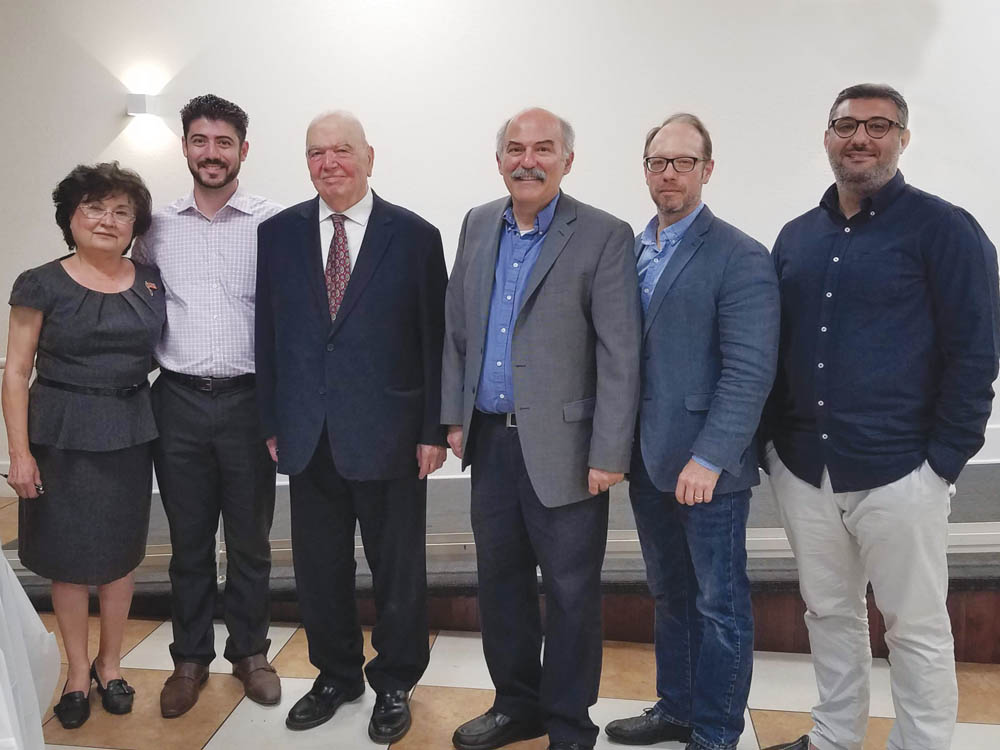
Dr. Richard Hovannisian, Prof. Barlow Der Mugrdechian, Dr.
Sergio La Porta, and Dr. Ümit Kurt. Photo: ASP Archive
David Safrazian
Staff Writer
“My Armenian identity is shaped by the Armenian flag and it gave me a sense of purpose. It was to be idealistic and not a realist,” said Dr. Richard Hovannisian.
Dr. Hovannisian was invited to give a lecture titled “The Republic of Armenia: A Daring Endeavor, 1918-2018,” on Thursday, November 1, in the Charles and Alice Gureghian Cultural Center in Fresno. Dr. Hovannisian’s lecture was part of the activities organized in Fresno to commemorate the 100th anniversary of Homenetmen. His talk was co-sponsored by the Homenetmen Fresno Sassoon chapter, the Armenian Studies Program at Fresno State, and the Hamazkayin Taniel Varoujan chapter.
Dr. Hovannisian gave a fascin-ating presentation interweaving many topics, such as his family history and the early history of the First Republic of Armenia, with an overall theme of Armenian identity.

Photo: Andrew Hagopian
Dr. Hovannisian began his talk by discussing his own personal journey on how he discovered more about his Armenian identity. He then reflected on the challenges facing Armenia today, comparing the challenges Armenia faces today with those that Armenia faced after gaining independence in 1918.
The First Republic of Armenia was born in the chaos of war and Genocide and faced daunting challenges to simply survive its first year. By September 1920, the Republic of Armenia had been abandoned by the great powers and by December of that year the Republic collapsed.
In order to save the territory that remained, eleven thousand square miles, the Armenian government was forced to hand over power to the communists, but that did not help Armenia reclaim the territory promised by the Allies that was lost.
Dr. Hovannisian showed pho-tos of significant Armenians, whose contributions enhanced the early Republic of Armenia.
Dr. Hovannisian was the first holder of the Armenian Educational Foundation Chair in Modern Armenian History at UCLA. He received his B.A. and M.A. in history from UC Berkeley and his Ph.D. from UCLA.
His dissertation, “On the Road to Independence, 1918” was a ground-breaking work looking at the formation of the Armenian Republic.
It led him to write a four-volume history of the Republic of Armenia, a project which he thought initially would take three years, but which turned out to be a thirty year journey.
Dr. Hovannisian joined the UCLA faculty in 1962 and was associate director of the UCLA von Grunebaum Center for Near Eastern Studies from 1978-1995. He has published more than thirty books, seven on the Armenian Genocide.
Dr. Hovannisian was born in Tulare, CA and did not speak Armenian fluently until he attended the Jemaran Armenian school in Beirut, Lebanon. He grew up in an English-speaking household and didn’t know much about his heritage or Armenian history. Since there were only a few Armenians in Tulare, he did not have many Armenians to interact with.
Dr. Hovannisian did not know his father’s genocide story until just before his father’s death because his father never wanted to talk about the horrors he faced.
Dr. Hovannisian talked about the history of Homenetmen, the Armenian General Athletic Union, which was founded in Constantinople in November 1918.
At the end of the lecture, Dr. Hovannisian was presented with an award by the Homenetmen Fresno Sassoon Chapter.
 Hye Sharzhoom Armenian Action
Hye Sharzhoom Armenian Action